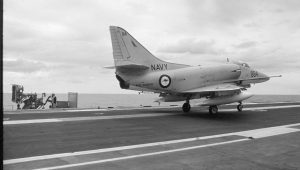- Author
- A.N. Other
- Subjects
- Naval Aviation
- Tags
-
- RAN Ships
- HMAS Albatross (Shore Establishment), 805 Squadron, HMAS Melbourne II
- Publication
- December 2011 edition of the Naval Historical Review (all rights reserved)
By John Da Costa
Following the reversal, in the early 1960s, of an earlier Australian Government decision to disband the RAN Fleet Air Arm and to pay-off the carrier HMAS Melbourne, a Navy Office search commenced to identify replacements for the RAN’s aging fixed-wing aircraft. In the case of the Sea Venom All Weather and Nightfighter, the choice narrowed down to the A4 Skyhawk aircraft, used by the US Navy (USN) predominantly in the Air-to-Ground ‘Attack’ role, but also in limited numbers as a ‘fighter’ when operating from the USN’s Anti-Submarine Warfare carriers of the Modified Essex class. Out of all naval aircraft then available and capable of operating from a Light Fleet Carrier, the Skyhawk undoubtedly had the best all-round capability in both the attack and fighter roles. The doubts expressed by some aviation ‘experts’ in Defence as to the ability of Melbourne to operate these aircraft were dismissed when, in May 1965, a USN Skyhawk successfully carried out an arrested landing on Melbourne, followed by a catapult launch.
The A4G model Skyhawk to be purchased for the RAN was, apart from certain electronic warfare equipment that the RAN was not purchasing, to be built to the same specifications as the latest USN A4F model. It had the current USN avionics, radar and weapons delivery systems and the J52-P8A engine. Additionally, unlike its USN counterpart, it was wired to carry up to four AIM9B Sidewinder AAMs on wing stations, interchangeable with the normal attack weapons fit.
In 1967, LCDR John Da Costa and LEUT Grahame (Dusty) King, the CO and Senior Pilot (designates) of the RANs yet-to-be-recommissioned 805 Squadron, were posted to the US Navy’s Attack Squadron 125 (VA125) at NAS Lemoore, California, for five months of A4 Skyhawk training in preparation for returning to Australia to conduct the first RAN Skyhawk Operational Flying School (OFS). At the time, the Vietnam War was placing great demands on USN Carrier Air Groups. To keep up the demand for A4 Skyhawk pilots, the very large VA125 was running a continuous Replacement Air Group (RAG) training programme with a syllabus which, fortuitously, met most of the RAN’s requirements. The two RAN pilots were experienced in carrier operations in the RAN’s 1950s era Hawker de-Havilland Sea Venom subsonic all-weather day/night fighter in the primary role of air defence (4 x 20 mm cannon) and limited secondary role of air to surface attack (cannon and unguided 3-inch Air-to-Ground rockets). LCDR Da Costa was a graduate of the Royal Navy’s Air Warfare Instructors Course and LEUT King was a Qualified Flying Instructor and Instrument Rating Examiner. Neither had much experience as ‘attack’ pilots; rather, their training had been more in the fighter/air defence role.

Perhaps the greatest difference that they experienced was that they were coming from a relatively small naval aviation community, quite at home with one aircraft carrier and a Naval Air Station and having Naval Air Squadrons of 6 to 10 aircraft, commanded by officers of LCDRs rank. By contrast, at NAS Lemoore, California, the VA125 flight line had a lineup of 100 Skyhawks each morning, ranging from the ‘ancient’ A4B (by then relegated to the In-flight Refuelling Tanker role) right through to the latest version (TA4F). Pilots almost needed a map to find their allocated aircraft on the flight line. The airfield had parallel 14,500 ft. concrete runways. The CO VA125 was a four-ring Captain and both the XO and Operations Officer were Commanders. There was an enormous A4 RAG student population ranging from Ensigns straight out of the USNs Pensacola Flight School, to ex-ASW (and other) pilots of Commander’s rank, just busting to get to Vietnam! The A4 RAG syllabus was entirely attack orientated and fully met that aspect of the RAN’s requirements. Highlights were the ‘Sandblower’ low level navigation and attack exercises over much of the Nevada and Arizona deserts. There was no ‘fighter’ phase of the USN’s A4 training so special arrangements were made for RAN pilots to carry out a one week deployment to MCAS Yuma, Arizona, for air-to-air gun attacks on towed banner targets, Ground Controlled Interception training and Sidewinder firings against parachute flare targets.
Having had considerable air-to-air experience in the RAN using a gyroscopic lead-predicting gun-sight, the RAN pilots were somewhat deflated to find that they were now in a similar position to much earlier World War I fighter pilots as they tried to get shells to hit the towed banner using the Skyhawk’s ‘fixed’ bombing gun-sight! They also had a problem getting adequate ranging information when firing Sidewinders against a stationary flare target. (Sidewinder ranging proved less of a problem later because, after training using ‘captive’ Sidewinder missiles, the A4’s in-built terrain avoidance APG53A radar and visual air-to-air ranging, squadron pilots became proficient at getting themselves into the Sidewinder firing position. ‘Live firings’ were also conducted against the TONIC heat-source target towed by a JINDIVIK drone at the Jervis Bay Missile Range).




